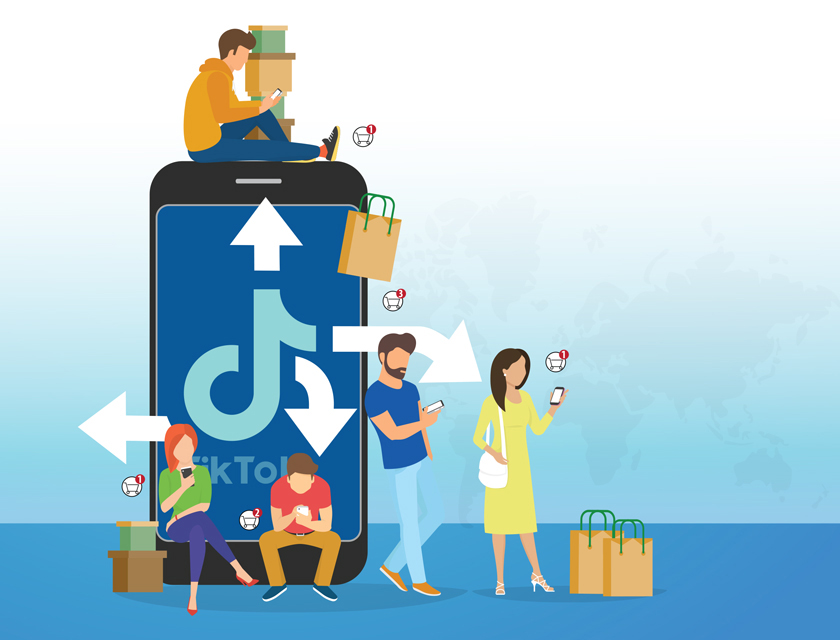
By Alan Young
TikTok has become a worldwide phenomenon spanning across age groups and a marketing tool for both B2C and B2B brands
If you think TikTok is a corner of social media reserved solely for digitally-savvy teens with a penchant for dancing or lip-syncing in front of the camera – think again. While the platform initially made waves due to its virality amongst a younger demographic (here’s to you, Generation Z), TikTok has since evolved to not only become a worldwide phenomenon spanning across age groups but a critical marketing tool for both B2C and B2B brands.
In fact, it’s one of the fastest-growing social media apps today, with over 1 billion monthly active users (a close rival to the likes of Instagram, which boasts approximately 1.4B monthly users). With a newsfeed – better known as the ‘For You Page’ – that is designed similarly to a slot machine, users can easily find themselves drawn into an irresistible sequence of viral clips, including choreographed dances, travel vlog highlights, unboxing videos, celebrity interviews, TV recaps, funny moments, behind the scenes clips, and so much more.
Tourism boards around the world are choosing TikTok to showcase their countries’ travel destinations with a global travel campaign #TikTokTravel across 100 countries and regions to inspire users to creatively capture and share their travel moments. Avani Hotels and Resorts has launched its own channel on the video sharing app, reaching a younger generation of travellers through the #TikTokTravel hashtag. The company will profile “under-the-radar journeys and experiences” in the locations of its 30 properties in 15 countries worldwide, through curated content and collaborations with leading TikTokers.
Since its inception, the platform has amassed an ever-growing legion of entertainers and creators who boast an intimate understanding of the algorithm and what attracts more views, shares, and followers. From a branding perspective, TikTok now represents an incredible opportunity for growth and recognition, whether brands leverage creators’ platforms to market their products or use the app to establish a unique online presence. So, if your brand finds itself on the outside looking in at the app that continues to receive worldwide fanfare and cultural momentum, could it be time for you to join the party?
An Under-utilised Medium for B2B Marketing
LinkedIn may be the platform of choice for most B2B brands, but that shouldn’t mean that TikTok is entirely left out of the conversation. In fact, TikTok’s ad revenue grew from $1.3 billion in 2020 to $2.1 billion in 2021. Statista predicts TikTok ad revenue will nearly triple to $5.96 billion this year and grow to $11 billion by 2024.
Moreover, the platform presents a unique opportunity to drive awareness of your brand in a way that feels authentic and personal. While exploring the social network, you may even stumble upon critical industry insights – more specifically, industry and end-user pain points – which can be leveraged as a value proposition for a B2B brand’s product or service. By keeping up with consumers’ cultural moments, preferences, and interests (in this case, travellers), B2B hospitality brands will remain better connected with (and more visible to) their potential buyers, too.
Not to mention, TikTok provides an opportunity for brands to have fun with a marketing strategy that may otherwise appear too formal or rigid via more traditional mediums. The platform thrives on behind-the-scenes moments and gives companies a medium to develop more of a brand personality while showcasing their team, company culture, customer success stories, and more. On TikTok, creativity is rewarded, and the push to market on this platform may be the catalyst to a much-needed B2B content marketing shake-up. Could B2B marketing finally become binge-worthy rather than boring? I don’t know about you, but I like the sound of that.
A Tool for Wanderlust
If a picture is worth a thousand words, what is a video worth? In the world of TikTok, video is the only currency exchanged, and it packs some undeniable buying power with respect to the attention and interest of consumers. More importantly, video is a content medium that allows for a great deal of creative expression served up in a manner inherently designed to be enjoyed and shared. Simply put, video content has the power to make viewers feel something – whether that’s inspiration, joy, excitement, heartbreak, shock, or the emotional response our industry is most interested in: wanderlust.
Just as a video is a powerful tool, wanderlust is a powerful behavior driver, and a feeling well understood across the masses. After all, time spent in other corners of the world represents an opportunity to disconnect, reconnect, explore new cultures, meet new people, network, relax, and indulge in luxury. The ability to press ‘pause’ on our everyday life in favor of a new landscape and culture is an incredible privilege and one that many of us may feel we don’t get to experience frequently enough. Thus, wanderlust has become a natural part of our life, and the sensation often comes surging to the forefront of our consciousness when we see visually stunning, carefully edited videos that showcase and tease the experience offered by a destination. Combine that wanderlust, carefully curated for a platform with a track record of virality, with the experience of “FOMO” (Fear of Missing Out) that social media is notorious for creating, and you have an undeniably powerful marketing formula. Let’s consider the following statistics:
- FOMO is experienced by 69% of millennials (Eventbrite)
- Travel (59%), parties and events (56%), and food (29%) are the biggest things that create FOMO among millennials (Strategy)
- FOMO is experienced by 56% of social media users
- After experiencing FOMO, 60% of millennial consumers said they make a reactive purchase. (Skulocal)
- Millennials are 30% more likely to trust UGC (User-Generated Content) when compared to baby boomers
When we look at TikTok specifically, we see that the platform has not only been the most downloaded social media app multiple years in a row, but it also reigns supreme as the top-grossing app, surpassing $2.5 billion in consumer spending in 2021. Reports indicate that Eight new users join TikTok every second, and the app is expected to reach 1.5 billion users by the end of this year. Perhaps more importantly, TikTok has now surpassed Instagram for popularity among Gen Z users (born between 1997 and 2012) in the United States, which is a travel segment many hospitality brands are eager to better connect with and advertise to.
To this effect, Skift author Carley Thornell recently pointed out that well-done short-form videos create a feeling of authenticity, and savvy, independent hotels are cashing in. “Hotel marketers are using short-form video campaigns on the social media app TikTok to score views from millions of potential guests,” Thornell wrote. “In many cases, this interest — revealed through the popularity of tags such as #smallluxuryhotels(more than 3 million views), #hoteldesign (more than 13 million views), and #besthotel (33 million views) — is prompting people to book trips.” Richard Hyde, the managing director of Small Luxury Hotels who was quoted in Thornell’s piece, also noted the platform’s potential as far more than just a dance-trend app. “The platform is rapidly aging up,” said Hyde. “We’ve seen engagement from users of all ages on our Small Luxury Hotels of the World account.”
With this in mind, can travel and hospitality brands (technology providers, hotels, and the like) really afford to leave this platform out of their content marketing strategy? The answer is no – and the clock is ticking until a competitor brand moves into social media real estate you left unoccupied. See what I did there?


